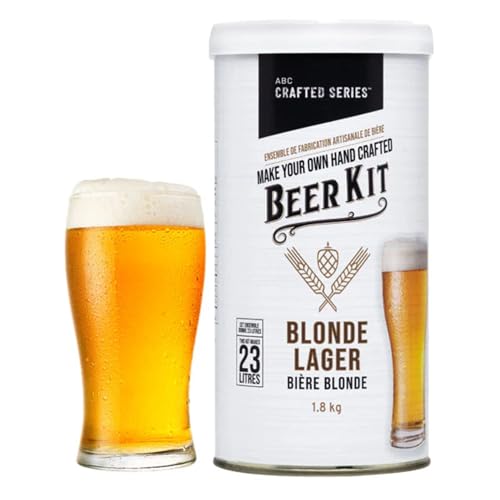CROSSMYLOOF BEIRM YEAST
ATLANTIC. Suitable to brew subtle ester ales with a round palate.
Attenuation: 74-78%
Flocculation: Medium
Fermentation: ideally 19-22°C
Max ABV 9% in 20 litres - Pitching Rate: 50g/100 litres
INGREDIENTS:Yeast (Saccharomyces cerevisiae), emulsifier E491
What to expect? Similar US-05 but with a rounder palate
BEòIR. Scottish & Irish Ale Yeast.
Suitable for a large range of ales inc. cask conditioned ale
Attenuation: 73-75%
Flocculation: Good
Fermentation: ideally 15-22°C (59-72°F)
Max ABV 9% in 20 litres - Pitching Rate: 50g/100 litres
INGREDIENTS:Yeast (Saccharomyces cerevisiae), emulsifier E491
CLIPPER. New England Ale Yeast.
Suitable for a hoppy beer requiring tropical aromas
Attenuation: 75% +/- 5%
Flocculation: Medium
Fermentation: ideally 15-22°C (59-72°F)
Max ABV 9% in 20 litres - Pitching Rate: 50g to 90g/100 litres
INGREDIENTS:Yeast (Saccharomyces cerevisiae), emulsifier E491
What to expect? Similar to London ale III
FOUR. English Ale Yeast. Suitable for a large range of ales inc. Bitter, IPA, Brown Ale, Stouts, etc..
Attenuation: 72-75%
Flocculation: Good
Fermentation: ideally 15-22°C (59-72°F)
Max ABV 9% in 20 litres- Pitching Rate: 50g/100 litres
INGREDIENTS:Yeast (Saccharomyces cerevisiae), emulsifier E491
What to expect? Similar to S-04
FLUSHED NUN. Abbey Ale Yeast. A phenolic, spicy and fruity one for Belgian, Trappist & Abbey Ales
Attenuation: 73-79%
Fermentation: ideally 18-28°C (64-82°F)
Flocculation: Med/High
Max ABV 13% in 20 litres- Pitching Rate: 40g/100 litres
INGREDIENTS:Yeast (Saccharomyces cerevisiae), emulsifier E491
FIVE. US Ale Yeast. Suitable to brew low ester ales with a clean palate
Attenuation: 76-80%
Fermentation: ideally 17-28°C (63-82°F)
Flocculation: High
Max ABV 9% in 20 litres- Pitching Rate: 50g/100 litres
INGREDIENTS:Yeast (Saccharomyces cerevisiae), emulsifier E491
What to expect? Similar to US-05
GRETEL. Hefeweizen Yeast.
Suitable to brew wheat beers. A diastatic yeast with loads of clove and banana
Attenuation: 85-90%
Flocculation: Low
Fermentation: Ideally 18-30°C (64-86°F)
Max ABV 11% in 20 litres- Pitching Rate: 60g/100 litres
INGREDIENTS:Yeast (Saccharomyces cerevisiae var. Diastaticus), emulsifier E491
What to expect? Similar WB-06 in profile
HAZE. US Ale Yeast.
Suitable to brew ales with low esters, leaving a slight haze.
Attenuation: 75%
Fermentation: ideally 15-20°C (59-68°F)
Flocculation: Low
Max ABV 9% in 20 litres- Pitching Rate: 50g/100 litres
INGREDIENTS:Yeast (Saccharomyces cerevisiae), emulsifier E491
What to expect? Similar US-05 but leaves a slight haze
HELL. Bottom Fermenting Berlin Pilsner Yeast.
Suitable for rounded German lagers
Attenuation: 76-82%
Flocculation: High
Fermentation: ideally 12-21°C (54-70°F)
Max ABV 9% in 20 litres @ 21°C- Pitching Rate: 75g/100 litres
(It’s preferable to double pitch @ 12°C)
INGREDIENTS:Yeast (Saccharomyces pastorianus), emulsifier E491
What to expect? Similar to s-23
HøG-NORSK. Northern European Ale Yeast.
Suitable to brew low ester ales with a clean palate
Attenuation: 75-80%
Flocculation: High
Fermentation: ideally 18-27°C (64-80°F)
Max ABV 9% in 20 litres - Pitching Rate: 50g/100 litres
INGREDIENTS:Yeast (Saccharomyces cerevisiae), emulsifier E491
What to expect? Similar to K-97
HOUSE. Table Ale Yeast with a Mellow Ester.
Suitable for a wide range of beers i.e. English Ales, Continentals to IPAs
Attenuation: 68-72%
Flocculation: Medium
Fermentation: ideally 18-22°C (64-72°F)
Max ABV 11% in 20 litres - Pitching Rate: 50g/100 litres
INGREDIENTS:Yeast (Saccharomyces cerevisiae), emulsifier E491
What to expect? Similar to S-33
KENTUCKY. Common Ale Yeast. Suitable for a large range of ales ranging from Commons, Kölsch, Cream Ales and pale ales with a clean edge.
Attenuation: 77-83%
Flocculation: High
Fermentation: ideally 13-22°C (55-72°F)
Max ABV 9% in 20 litres- Pitching Rate: 60g/100 litres
INGREDIENTS:Yeast (Saccharomyces cerevisiae), emulsifier E491
MIDLAND. Trent Ale Yeast. Suitable for a large range of ales ranging from Nottingham type Ales, Pales, Porters and Bitters
Attenuation: 76-82%
Flocculation: High
Fermentation: ideally 14-22°C (55-72°F)
Max ABV 10% in 20 litres- Pitching Rate: 60g/100 litres
INGREDIENTS:Yeast (Saccharomyces cerevisiae), emulsifier E491
What to expect? Similar to Nottingham
MONK. Monastery Ale Yeast.
Suitable to brew ales with a medium ester profile.
Attenuation: 68-77%
Flocculation: Medium
Fermentation: Ideally 15-20°C (59-68°F)
Max ABV 9% in 20 litres - Pitching Rate: 50g/100 litres
INGREDIENTS:Yeast (Saccharomyces cerevisiae), emulsifier E491
PIA. Kiwi Pale Ale Yeast.
Suitable to brew pale ales with a good hop profile.
Attenuation: 73-75%
Flocculation: Good
Fermentation: ideally 15-22°C (59-72°F)
Max ABV 9% in 20 litres - Pitching Rate: 50g/100 litres
INGREDIENTS:Yeast (Saccharomyces cerevisiae), emulsifier E491
THE FIRM. A Low Attenuating Yeast.
Suitable for anything that requires a fruitier finish, or perfect for low alcohol pales, etc...
Attenuation: 63-68%
Flocculation: Medium
Fermentation: Ideally 18-22°C (64-72°F)
Max ABV 8 to 9% in 20 litres - Pitching Rate: 50g/100 litres
INGREDIENTS:Yeast (Saccharomyces cerevisiae), emulsifier E491
What to expect? Similar to Windsor but with a slightly different taste
WALLONIA. Saison Yeast.
Suitable for anything that requires an ester finish - Soft fruit, citrus & spice. A diastatic yeast strain.
Attenuation: 85-92%
Flocculation: Medium
Fermentation: Ideally 16-30°C (61-86°F)
Max ABV 11% in 20 litres - Pitching Rate: 50g/100 litres
INGREDIENTS:Yeast (Saccharomyces cerevisiae var. Diastaticus), emulsifier E491
What to expect? Similar to WLP590?
Pitching Directions
Pitch the yeast directly on to the surface of the wort at the fermentation temperature (or at a temperature slightly above). Sprinkle well over the wort surface to avoid clumping. Aerate well with a sterilised spoon in a splashing motion for 5 minutes.
Rehydrating
Alternatively, sprinkle the yeast in 100ml of sterile water or boiled wort at 24 to 29°C (75°F to 84°F)*. Leave to rest 15 to 30 minutes, gently stir and pitch the resultant cream into the fermentation vessel. *Hell Pilsner yeast rehydration temp is between 15 to 25°C (59°F to 77°F)
Storage
Transportation: The yeast can be transported at room temperature for up to 3 months without affecting its performance. Once you receive it store in cool (< 10°C/50°F), dry conditions.
Shelf Life: Refer to the best before end date printed on the sachet label. Opened sachets must be sealed and stored at 4°C (39°F) and used within 7 days of opening. Do not use damaged sachets.












![Craft A Brew - Safale S-04 Dry Yeast - English Ale Dry Yeast - For English and American Ales and Hard Apple Ciders - Ingredients for Home Brewing - Beer Making Supplies - [3 Pack]](https://m.media-amazon.com/images/I/41vpOQ2OvTL._SL500_.jpg)

